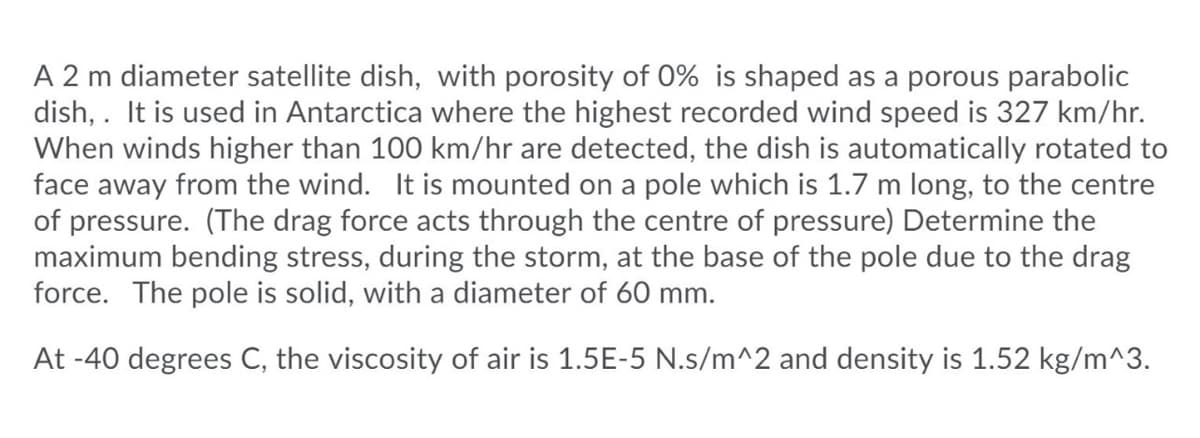A 2 m diameter satellite dish, with porosity of 0% is shaped as a porous parabolic dish, . It is used in Antarctica where the highest recorded wind speed is 327 km/hr. When winds higher than 100 km/hr are detected, the dish is automatically rotated to face away from the wind. It is mounted on a pole which is 1.7 m long, to the centre of pressure. (The drag force acts through the centre of pressure) Determine the maximum bending stress, during the storm, at the base of the pole due to the drag force. The pole is solid, with a diameter of 60 mm. At -40 degrees C, the viscosity of air is 1.5E-5 N.s/m^2 and density is 1.52 kg/m^3.
A 2 m diameter satellite dish, with porosity of 0% is shaped as a porous parabolic dish, . It is used in Antarctica where the highest recorded wind speed is 327 km/hr. When winds higher than 100 km/hr are detected, the dish is automatically rotated to face away from the wind. It is mounted on a pole which is 1.7 m long, to the centre of pressure. (The drag force acts through the centre of pressure) Determine the maximum bending stress, during the storm, at the base of the pole due to the drag force. The pole is solid, with a diameter of 60 mm. At -40 degrees C, the viscosity of air is 1.5E-5 N.s/m^2 and density is 1.52 kg/m^3.
Principles of Heat Transfer (Activate Learning with these NEW titles from Engineering!)
8th Edition
ISBN:9781305387102
Author:Kreith, Frank; Manglik, Raj M.
Publisher:Kreith, Frank; Manglik, Raj M.
Chapter5: Analysis Of Convection Heat Transfer
Section: Chapter Questions
Problem 5.50P
Related questions
Question

Transcribed Image Text:A 2 m diameter satellite dish, with porosity of 0% is shaped as a porous parabolic
dish, . It is used in Antarctica where the highest recorded wind speed is 327 km/hr.
When winds higher than 100 km/hr are detected, the dish is automatically rotated to
face away from the wind. It is mounted on a pole which is 1.7 m long, to the centre
of pressure. (The drag force acts through the centre of pressure) Determine the
maximum bending stress, during the storm, at the base of the pole due to the drag
force. The pole is solid, with a diameter of 60 mm.
At -40 degrees C, the viscosity of air is 1.5E-5 N.s/m^2 and density is 1.52 kg/m^3.
Expert Solution
This question has been solved!
Explore an expertly crafted, step-by-step solution for a thorough understanding of key concepts.
This is a popular solution!
Trending now
This is a popular solution!
Step by step
Solved in 2 steps with 2 images

Recommended textbooks for you

Principles of Heat Transfer (Activate Learning wi…
Mechanical Engineering
ISBN:
9781305387102
Author:
Kreith, Frank; Manglik, Raj M.
Publisher:
Cengage Learning

Principles of Heat Transfer (Activate Learning wi…
Mechanical Engineering
ISBN:
9781305387102
Author:
Kreith, Frank; Manglik, Raj M.
Publisher:
Cengage Learning